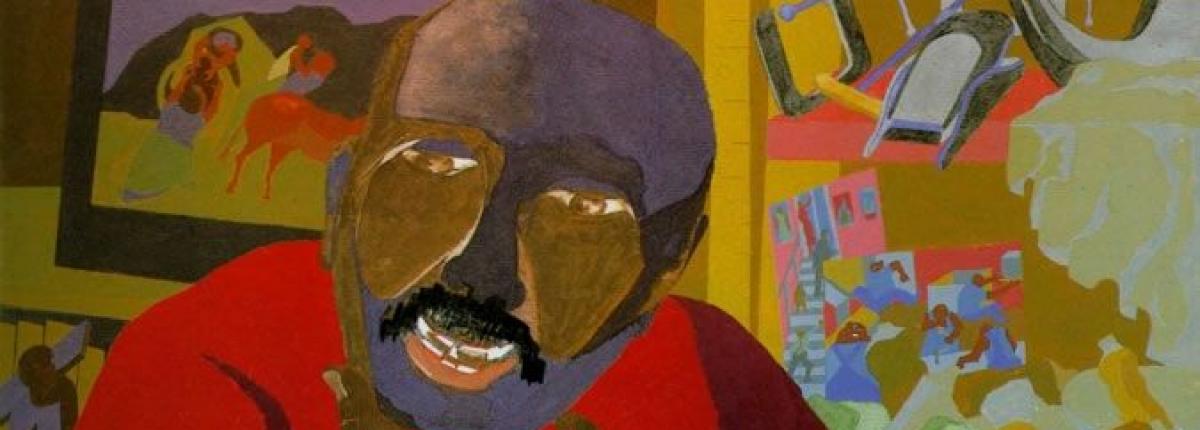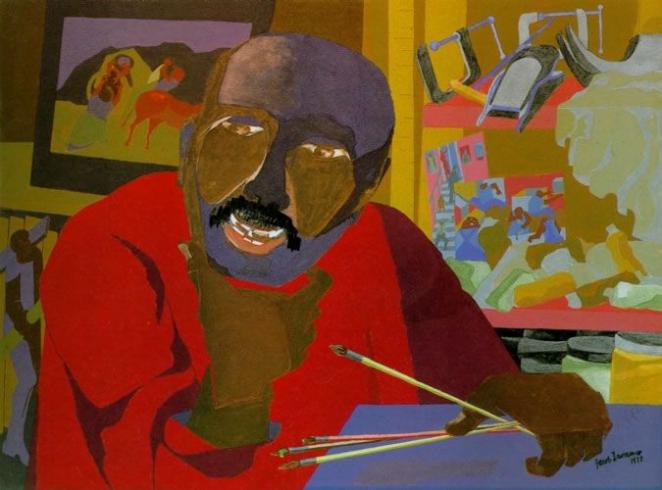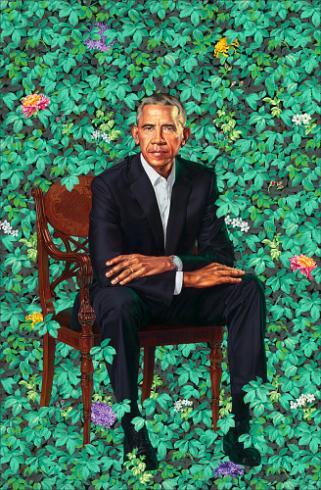Lawrence's Legacy: Who We Are

Part 1: Painting Portraits
Introduce:
- Share with students that they will be learning a little bit about the artist Jacob Lawrence and the leader of the Haitian Revolution, Toussaint L’Ouverture:
- Lawrence was a famous American painter who depicted and celebrated the lives and experiences of African Americans, and Black people more widely, through his art.
- Lawrence painted portraits of famous Black people, including the leader of the Haitian Revolution, Toussaint L’Ouverture.
- L’Ouverture was born a slave in 1743, but rose to become the leader of the Haitian Revolution. He helped establish Haiti’s first democratic constitution in 1800. Although he died under France’s custody in 1803, he set the stage for Haiti to become an independent country in 1804.
- Watch this video about Jacob Lawrence’s series The Life of Toussaint L’Ouverture.
- In groups of 4, have students study these paintings from the Life of Toussaint L’Ouverture series, which were on view at The Phillips Collection in 2017.
- View more images and information on Culture Type and Art in Print.
- Each group should select four paintings from the series. For each of the paintings, they should use the See, Think, Wonder strategy and capture their thoughts on chart paper in three columns: “See,” “Think,” and “Wonder.” Students should write down:
- What do they see in the paintings, and what details stand out?
- What do they think is happening, and what makes them think that?
- What do they wonder as they look at the painting, and what big questions come to mind?
- Each group should present their charts to the rest of the class, being sure to show with which paintings their observations correspond.
Discuss:
- Based on the presentations, engage in a whole class discussion focused on the following questions:
- What are some reasons why Jacob Lawrence may have decided to paint a series about the life of Toussaint L’Ouverture?
- How does this series about the life of Toussaint L’Ouverture support Lawrence’s statement in the video: “I was dealing with subject matter pertaining to the Black experience [so] I decided to do a number of paintings on Toussaint L’Ouverture. You’d walk along the street and you’d hear them talking about this great [figure]—I’m sure much of what they said was romanticized—but that didn’t matter. What mattered was that you had something to be proud of, something to look up to”?
Part 2: Lawrence’s Legacy
Reflect:
- Explain to students that Lawrence’s portraits inspired a new generation of Black artists to reframe the narrative around how society views Black people. One such artist is Kehinde Wiley.
- Discuss with students:
- In your opinion, how can art and media (such as music, television, film, and visual arts) shape the way you think about people who may have a different background, race, or culture from you?
- In what ways can art and media perpetuate racial and cultural stereotypes?
- In what ways can art and media help us challenge racial and cultural stereotypes?
- How have you seen art and/or media tell counternarratives?
- In their small groups, students will study and make connections between the following paintings from Jacob Lawrence and Kehinde Wiley, using the Portrait Deep Dive handout.
- Lawrence
- Self-Portrait,1977
- Frederick Douglass, Panel no. 21, 1939
- The Shoemaker, 1945
- Wiley
- Ice T, 2005
- LL Cool J, 2005
- Barack Obama, 2018 (Read more about the Obama portrait here)
- Lawrence
- As they’re studying the paintings, students should discuss and write down their responses to the questions on the Portrait Deep Dive handout.
- Teacher note: You and your students might notice that all of these portraits depict men. You could use this fact as a discussion point and pose the following question: In your opinion, what are some reasons these artists may have chosen to use men more frequently as their subjects? Think about the time periods when the artists created their work as you reflect on this question.
- Discuss the questions as a whole group and add the following question to the discussion:
- How do you think Lawrence’s art may have influenced the narratives portrayed by contemporary artists such as Kehinde Wiley?
Part 3: Creating Portraits
- Students will create self-portraits that capture who they are, using this Self-Portrait Planner to get started.
- To create their self-portraits, students should try to use techniques they observed in Wiley and Lawrence’s paintings, including:
- Wiley: naturalism (looks like a real-life setting), vibrant colors, symbols of royalty
- Lawrence: geometric shapes, biomorphic shapes, limited color scheme
- Building upon their brainstorming ideas, students will create self-portraits using varied mediums. Teachers may want to limit materials or suggest what materials students can use, based on availability and resources.
- Remind students that they do not have to create self-portraits that look exactly like them, but instead focus on representing the complexity of their identity. They may opt to create a more abstract self-portrait or a more realistic self-portrait.
- To create their self-portraits, students should try to use techniques they observed in Wiley and Lawrence’s paintings, including:
Reflect:
- After the students create their self-portraits, have them write an artist statement considering:
- What story does my self-portrait tell?
- How does my self-portrait show who I uniquely am?
- Does my self-portrait break stereotypes? Explain why or why not.
- How does my self-portrait present a counternarrative or a story about myself that often goes untold?
Share:
- Create an art gallery for students to display their self-portraits.
- You can choose or have the students decide if they want to display their artist statements or show their artworks without the statement.
- Conduct a gallery walk.
- Each student should write down on a slip of paper one word that describes what each artist tried to communicate about themselves through the portrait (examples: beauty, strength, courage, intelligence, thoughtful, fun, etc.), and put their piece of paper in front of each portrait.
- Then, the students can read through their classmates’ responses and reflect on the messages conveyed through their portraits, considering the following questions:
- What additional messages did your classmates’ find in your self-portrait that you had not previously considered?
- How do your classmates’ interpretations add more meaning to your self-portrait?
- What can you learn from your portrait having so many interpretations in addition to the symbolism you initially intended?
Additional Context
Lesson Context
Lawrence not only painted scenes from his neighborhood, but he also painted portraits of people. Some of these portraits were of himself, some of everyday people doing everyday things, and some of famous people such as: abolitionist and political activist Harriet Tubman, leader of the Haitian revolution, Toussaint L’Ouverture, and social reformer and abolitionist Frederick Douglass. These portraits not only depicted the accomplishments and contributions of these people, but also provided, in his words, “something to be proud of, something to look up to.”
Jacob Lawrence paved the way for other African-American artists living and working after him to pursue art as a career. One such artist, Kehinde Wiley, is a Nigerian-American painter. He primarily paints portraits of Black people. These portraits have a naturalistic look to them. Wiley’s portraits are often based on the young men he sees in neighborhoods such as Harlem and South Central Los Angeles.
Wiley draws from different painting styles such as Renaissance paintings, Islamic architecture, and West African textile design. Wiley also mobilizes several other techniques in his portraits. The paintings are large in size and he often takes classic paintings with white subjects and replaces them with Black subjects to give them more prominence. Additionally, he has more recently expanded his subjects to include more women. Wiley has contributed to elevating the realities of queer Black people in America.
Key Terms
Counternarratives: Narratives told from the perspective of marginalized groups that counter the stories often perpetuated or told by dominant groups. Counternarratives serve as a way to reframe discussions and perceptions around different cultural and social groups. These stories give voice to those people who are often left out of dominant narratives.
Naturalistic: An artistic style that depicts real objects and people in a setting that resembles real life.
Portraiture: Art that shows a detailed depiction of a person.
Stereotype: A pervasive, fixed, oversimplified image or idea of a person, thing, or racial, ethnic, or cultural group.


